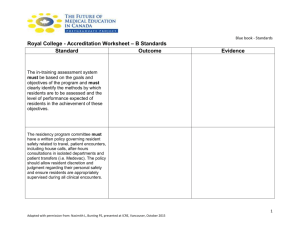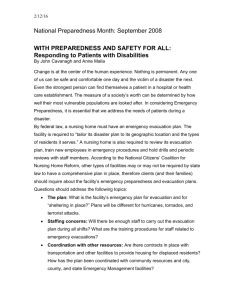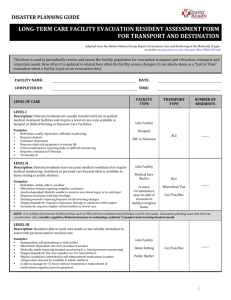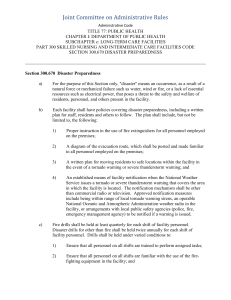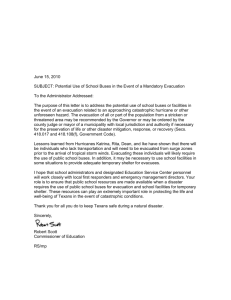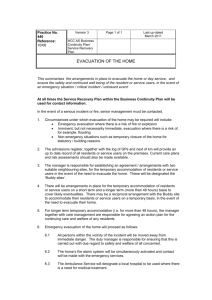Nursing Facility Emergency Planning
advertisement
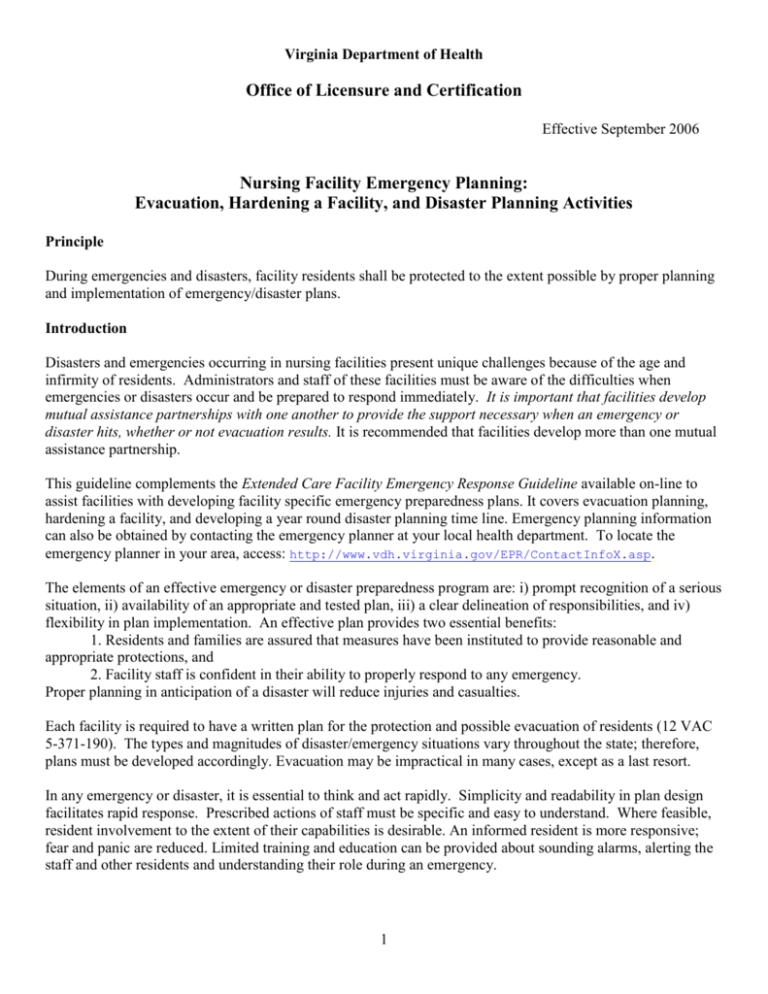
Virginia Department of Health Office of Licensure and Certification Effective September 2006 Nursing Facility Emergency Planning: Evacuation, Hardening a Facility, and Disaster Planning Activities Principle During emergencies and disasters, facility residents shall be protected to the extent possible by proper planning and implementation of emergency/disaster plans. Introduction Disasters and emergencies occurring in nursing facilities present unique challenges because of the age and infirmity of residents. Administrators and staff of these facilities must be aware of the difficulties when emergencies or disasters occur and be prepared to respond immediately. It is important that facilities develop mutual assistance partnerships with one another to provide the support necessary when an emergency or disaster hits, whether or not evacuation results. It is recommended that facilities develop more than one mutual assistance partnership. This guideline complements the Extended Care Facility Emergency Response Guideline available on-line to assist facilities with developing facility specific emergency preparedness plans. It covers evacuation planning, hardening a facility, and developing a year round disaster planning time line. Emergency planning information can also be obtained by contacting the emergency planner at your local health department. To locate the emergency planner in your area, access: http://www.vdh.virginia.gov/EPR/ContactInfoX.asp. The elements of an effective emergency or disaster preparedness program are: i) prompt recognition of a serious situation, ii) availability of an appropriate and tested plan, iii) a clear delineation of responsibilities, and iv) flexibility in plan implementation. An effective plan provides two essential benefits: 1. Residents and families are assured that measures have been instituted to provide reasonable and appropriate protections, and 2. Facility staff is confident in their ability to properly respond to any emergency. Proper planning in anticipation of a disaster will reduce injuries and casualties. Each facility is required to have a written plan for the protection and possible evacuation of residents (12 VAC 5-371-190). The types and magnitudes of disaster/emergency situations vary throughout the state; therefore, plans must be developed accordingly. Evacuation may be impractical in many cases, except as a last resort. In any emergency or disaster, it is essential to think and act rapidly. Simplicity and readability in plan design facilitates rapid response. Prescribed actions of staff must be specific and easy to understand. Where feasible, resident involvement to the extent of their capabilities is desirable. An informed resident is more responsive; fear and panic are reduced. Limited training and education can be provided about sounding alarms, alerting the staff and other residents and understanding their role during an emergency. 1 Virginia Department of Health Office of Licensure and Certification Effective September 2006 As a part of a local community, a facility is not alone in responding to emergencies or disasters. In the event of an internal emergency, the services of the local fire department, rescue squad, police department, or coordinator of emergency services may be needed. During community-wide emergencies, the emergency services response capability of the entire community is involved. During a disaster or emergency, the Administrator shall commit the totality of his own resources prior to seeking outside help. Assistance should then be requested from the local emergency operation center. General Information for developing an Facility Specific Evacuation Plan A. Plan activation criteria should address the: Primary management position that makes the decision to activate the plan Alternate management position if the primary person is unavailable Process for activating the plan, including notification of the receiving facility Process for communicating the evacuation decision to the alternative facilities Phases of plan implementation o Staff notification o Accessing available resources/equipment o Preparation of residents o Essential resident supplies B. Plan identification of alternative site/destination criteria should address the: Names, addresses and contact information of identified alternative/receiving facilities A copy of the written mutual assistance partnership agreements with alternative sites, i.e., memorandum of understanding, contract, or similar document Process for determining that destination is suitable for individual resident needs Assignment of residents to appropriate evacuation destinations, including evacuation to a hospital or home with a family member Process for assigning staff to individual residents as determined by the residents functioning status Location of list for easy access by staff when needed, and frequency of review to assure the list is kept current Frequency in which such documentation is reviewed and renewed C. Plan resources and evacuation criteria should address the: Resources/equipment available to move residents from the building, including elevators not in operation Clearly identifiable storage location of this equipment for easy access by staff when necessary, including nights and weekends Staff training protocol on equipment use Process for identifying residents who might need the equipment to safely evacuate, including method of identification, location of list for easy access by staff when needed, and frequency of review to assure the list is kept current Periodic inventory of the equipment to assure its availability and proper functioning when needed 2 Virginia Department of Health Office of Licensure and Certification Effective September 2006 D. Plan external transportation resources criteria should address the: Type of appropriate transportation (i.e., buses, vans, ambulances) needed to evacuate all residents safely, i.e., including non-ambulatory residents Backup or secondary appropriate transport resources A copy of the written documentation confirming the commitment of primary and secondary transport resource availability when needed, i.e., memorandum of understanding, contract, or similar document Process for identifying residents who might need the equipment to safely evacuate, including method of identification, location of list for easy access by staff when needed, and frequency of review to assure the list is kept current Frequency in which such documentation is reviewed and renewed F. Plan tracking destination/arrival of residents section should address the: Primary management position responsible for tracking resident arrival at the designated evacuation sites Process for pre-notifying residents and resident legal representative of the designated evacuation site Process to track the arrival of each resident at the designated site Process to ensure a well-organized return to the facility after the emergency has ended, including tracking to assure all residents have returned safely G. The resident contact notification should address the: Primary management position responsible for resident contact notification, including composing the evacuation notice and completion of designated notification activities Template of the script used for notification, i.e., where, how, why, etc. H. The government agency notification should include the: Primary management position responsible for notifying appropriate governmental agencies of the decision to evacuate Preferred method of notification, i.e., phone, fax, email Identification of local emergency operation center for community-wide emergencies Names and contact information of government agencies to notify, i.e., local fire officials and first responders, the Office of Licensure and Certification, local ombudsmen and, in the case of a community-wise emergency, the local emergency operation center I. Facility evacuation confirmation should address the: Process to verify that all resident rooms, offices, maintenance and kitchen facilities, and public rest rooms have been evacuated, e.g., orange tags, chalk on the door Staff training and drills on room evacuation, including annual in-service and orientation Process for arranging drills with local fire officials and other first responders J. Transport of records and supplies section should address the: Primary management position responsible for records management 3 Virginia Department of Health Office of Licensure and Certification Effective September 2006 Procedure for transport of resident clinical records Process to assure security and confidentiality of those records until return to the facility Method used to identify and ready resident specific treatment supplies for transport (minimum 3 day supply) Procedures to assure the secure transport of 3 day supplies of controlled substances including receipt, full count, authorizing signatures from both facilities, and return to the facility after the emergency has ended Location of information for easy access by staff when needed, and frequency of review to assure the list is kept current General Information for Hardening a Facility from Storm Related Damage1 ‘Hardening’ protects the integrity of the facility from damage during a major storm. More structural damage will occur to a building if wind enters than if the building is protected. I. Prior to annual hurricane season: Secure enough materials to harden the entire facility from storm damage. A day or 2 ahead of the projected storm, establish teams to begin installing plywood or shutters. Make sure there are 3 or 4 drills on hand to expedite installation. II. If hardening the entire building is not possible: 1 Designate rooms needing the least amount of hardening to be used to create central areas for sleeping, eating, daycare, etc. o Base on size and contents of the room as well as number of windows o Therapy rooms, dinning rooms and media rooms can be used as sleeping and eating areas for residents o Internal offices can be used as sleeping areas for staff Harden windows in: o Rooms with liquid oxygen o Kitchen and dietary to assure food preparation area stays operational o Medical records and payroll offices Harden exit doors at the end of hallways Internally harden rooms by: Our thanks to the Florida Health Care Association for sharing its disaster preparation materials! 4 Virginia Department of Health Office of Licensure and Certification Effective September 2006 o Closing smoke doors to create emergency zones in case a storm comes up suddenly or turns at the last minute o Rooms that cannot be hardened externally can be hardened internally by moving the resident to the hallway and closing the room door. o Cover computers with plastic bags and label appropriately Small internal rooms can be used to store water, computers and other items Shower rooms can be used to store garbage or act as a mortuary, if necessary o Consider ordering a couple of body bags in case a body must remain in situ until the storm passes 5 Virginia Department of Health Office of Licensure and Certification Effective September 2006 Calendar of Disaster Preparedness Activities2 The following calendar highlights the importance of emergency preparedness as a yearlong activity, not just each Fall during hurricane season. Month Activity January Begin review of disaster preparedness plan. Revise plan as needed as identified. February Inventory equipment and supplies to assure availability and proper functioning, including equipment needed for evacuation March Ensure all electronic records are safeguarded from lost, i.e., are they consistently backed-up? April Review disaster/emergency management plan to local fire officials, first responders and emergency management May Conduct education/training of staff, residents and families June Arrange and conduct drills with local first officials and emergency management Solicit staff availability during hurricanes July Send notification to resident caregivers about disaster plan and evacuation procedures Certify contract with outside vendors, including fuel delivery August Assess/update resident and staff emergency needs Ensure all new staff and residents are familiar with disaster and emergency plans. September Conduct ongoing reviews of disaster preparedness October Ensure all electronic records are safeguarded from lost, i.e., are they consistently backed-up? November Conduct ongoing reviews of disaster preparedness December Critique previous hurricane’s season’s experiences. 2 Our thanks to the Florida Health Care Association! 6 Virginia Department of Health Office of Licensure and Certification Effective September 2006 7
